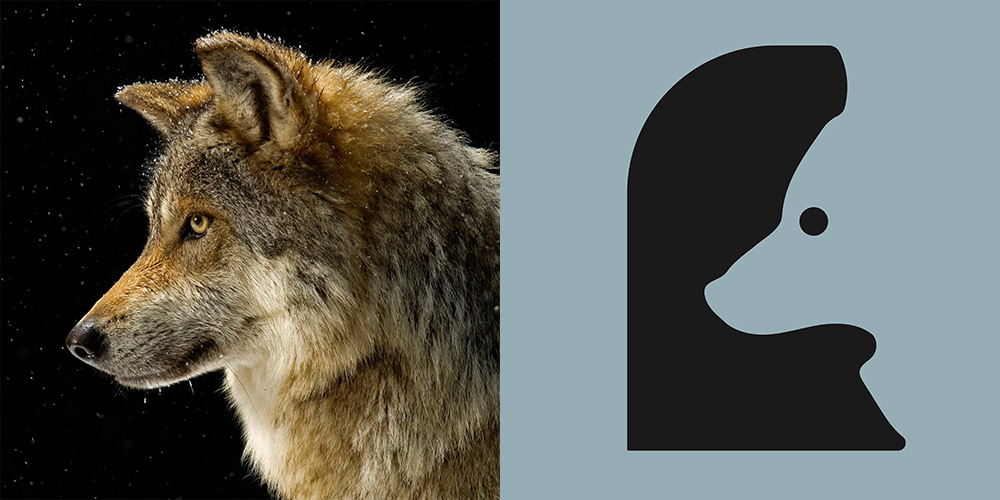
MAMMAL LOGO DESIGNS
( in profile )

Aardvark
The strange looking and almost mythical Aardvark (Orycteropus afer) is undoubtedly one of Africa’s most interesting animals. It plays a significant part in African folklore and mythology, and is believed to bring good luck to anyone that is lucky enough to see one. It is also a symbol of strength and resilience in various African cultures.
The name Aardvark is actually Afrikaans, and means “earth pig” or “ground pig”, probably because of its habit of burrowing into the soil for a home. Aardvarks are also known as ‘antbears’, ‘anteaters’, ‘Cape anteater’ and ‘earth hogs’.

White rhinoceros
is the largest extant species of rhinoceros. It has a wide mouth used for grazing and is the most social of all rhino species. The white rhinoceros consists of two subspecies: the southern white rhinoceros, with an estimated 19,682–21,077 wild-living animals in the year 2015, and the much rarer norther white rhinoceros. The northern subspecies has very few remaining individuals, with only two confirmed left in 2018

Fennec Fox
is a small crepuscular fox native to the Sahara Desert and the Sinai Peninsula. Its most distinctive feature is its unusually large ears, which serve to dissipate heat. The fennec is the smallest canid species. Its coat, ears, and kidney functions have adapted to the desert environment with high temperatures and little water. Also, its hearing is sensitive to hear prey moving underground. It mainly eats insects, small mammals, and birds. The fennec has a life span of up to 14 years in captivity and about 10 years in the wild

Horse
The relationship of the horse to humans has been unique. The horse is a partner and friend. It has plowed fields and brought in the harvest, hauled goods and conveyed passengers, followed game and tracked cattle, and carried combatants into battle and adventurers to unknown lands. It has provided recreation in the form of jousts, tournaments, carousels, and the sport of riding. The influence of the horse is expressed in the English language in such terms as chivalry and cavalier, which connote honour, respect, good manners, and straightforwardness.

Gray Wolf
Pervasive in mythology, folklore, and language, the gray wolf has had an impact on the human imagination and has been the victim of levels of misunderstanding that few animals have shared. With the exception of humans and the lion, the gray wolf once had a larger distribution than any other land mammal, once ranging over all of North America from Alaska and Arctic Canada southward to central Mexico and throughout Europe and Asia above 20° N latitude. It lived in every type of habitat except tropical forests and the most arid deserts, and it was the premier hunter of the large hoofed mammals. Several subspecies occur throughout North America, Eurasia, and Africa; however, classifications disagree on the number of wolf subspecies. Wolves were domesticated several thousand years ago, and selective breeding produced dogs.

Cat
The earliest known association between cats and humans dates possibly as far back as the origins of agriculture in the Middle East, about 9,500 years ago. A cat skeleton accompanying that of a human dated to that time was discovered in southern Cyprus. Although some sources note that this finding suggests that cats had undergone some degree of domestication in that location, other sources (citing evidence that the cat genome did not differ that much from that of the African wildcat during this period) argue that cats may have domesticated themselves by choosing to live in human-altered landscapes. Fossil evidence found in China dating to approximately 5,300 years ago revealed that cats similar in size to modern domestic cats fed on small grain-eating animals, such as rodents, and millet in agricultural settings. Although research suggests that these cats were actually leopard cats (Prionailurus bengalensis), which were replaced by modern domestic cats (F. catus) before 3000 bce, this discovery suggests that humans allowed cats to hunt mice and other rodents that threatened grain stores and possibly fed the cats or allowed them to consume leftover food.
Thank you for your time :)


